|
市场调查报告书
商品编码
1783022
工业机器人的数位&AI:2025年Digital & AI in Industrial Robotics Insights Report 2025 |
|||||||
样品预览

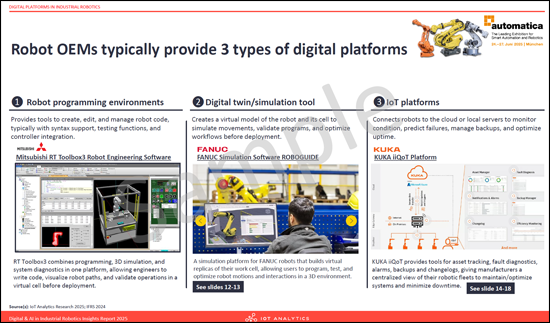
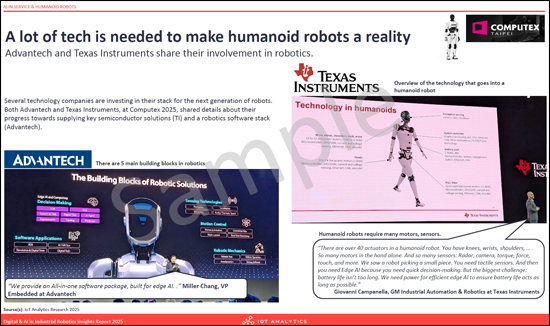
随着软体平台和人工智慧的进步重新定义自动化功能,工业机器人领域正在经历重大技术变革。对于製造、自动化和技术开发领域的领导者来说,准确、及时地了解这些趋势对于制定策略规划和保持竞争优势至关重要。
本报告分析了机器人领域数位平台和人工智慧的最新趋势,这是工业物联网和人工智慧持续研究的一部分。本报告是根据在德国慕尼黑举行的Automatica 2025展会上进行的50多次访谈以及一些二手资料。
样品预览
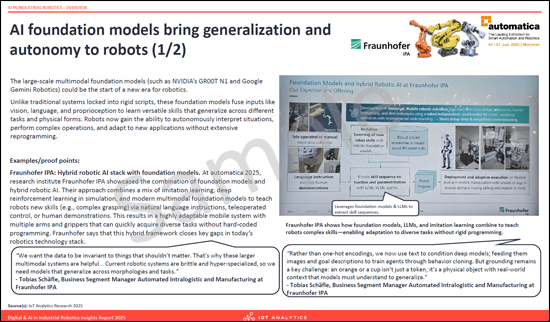
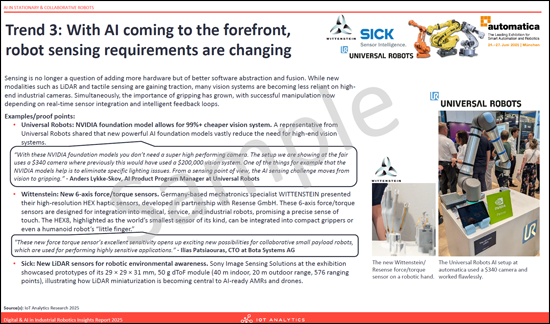
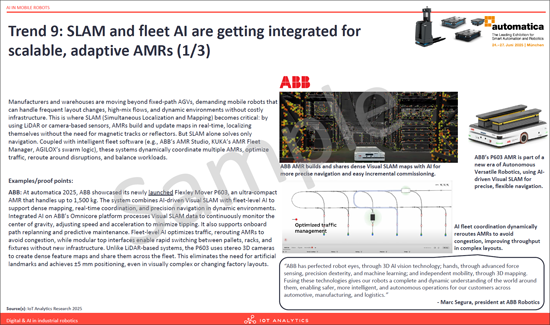
报告概述
- 58页PDF报告:一份详细的文檔,分析了最新的机器人趋势。
- 十大关键趋势分析:回顾机器人领域数位平台和人工智慧领域最重要的发展。
- 三家原始设备製造商 (OEM) 的详细比较:详细比较领先供应商的物联网平台、人工智慧配置和移动机器人产品。
- 访谈 50 多位专家的见解:在 Automatica 2025 展会上展示来自机器人原始设备製造商 (OEM)、新创公司和整合商的直接观点。
- 五种机器人类型的细分:概述固定式、协作式、移动式、服务式和人形机器人的角色和市场格局。
样品预览
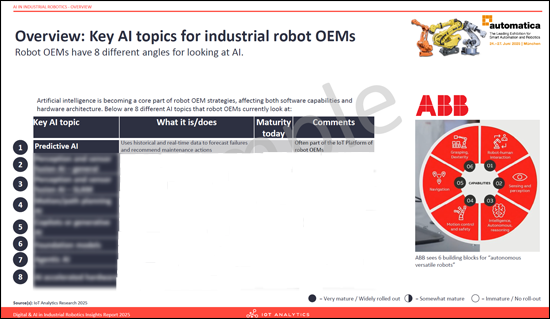
被言及了的企业
用本报告被言及的企业的一部分:
|
|
目录
第1章 简介
第2章 工业机器人的数位平台
第3章 工业机器人的AI
- 概要
- 固定式和协动型机器人的AI
- 移动机器人的AI
- 服务的AI和类人型机器人
第4章 关于IoT Analytics
A 58-page report analyzing the current state and future vision for software platforms and AI in industrial robotics - based on observations and 50+ expert interviews.
Sample preview



Introduction
The industrial robotics landscape is undergoing a significant technological shift as advancements in software platforms and artificial intelligence redefine automation capabilities. For leaders in manufacturing, automation, and technology development, a current and objective understanding of these trends is critical for strategic planning and maintaining a competitive edge.
As part of our ongoing coverage of industrial IoT and AI, this report presents a timely analysis of the state of digital platforms and AI in robotics. The insights are based on observations and over 50 interviews conducted at Automatica 2025 in Munich, Germany, supplemented by selected secondary research.
The result is a 58-page report compiled to help readers stay apprised of the newest trends in industrial robotics and the evolving market landscape. The report examines the software strategies of leading OEMs and provides a deep dive into the key use cases and technologies driving the next generation of industrial automation.
Sample preview



Report at a glance
- 58-page PDF report: A detailed document analyzing the latest robotics trends.
- Analysis of 10 key trends: A review of the most important developments in digital platforms and AI for robotics.
- 3 in-depth OEM comparisons: Detailed examinations of the IoT platforms, AI setups, and mobile robot offerings from leading vendors.
- Insights from 50+ expert interviews: Direct perspectives from robotics OEMs, startups, and integrators at Automatica 2025.
- Breakdown of 5 robot types: An overview of the roles and market status for stationary, collaborative, mobile, service, and humanoid robots.
Sample preview

Key areas of analysis:
The report's analysis includes an in-depth look at several key areas:
- OEM digital platform strategies: An examination of the three types of software platforms offered by robot OEMs: programming environments, digital twin/simulation tools, and IoT platforms. The analysis includes a detailed comparison of the IoT platform offerings of leading vendors.
- The role of AI in robotics: A deep dive into the key AI topics for industrial robot OEMs, including perception, motion planning, and the emerging role of foundation models. The report includes detailed comparisons of the AI setups of leading stationary and mobile robot manufacturers.
- Emerging technology trends: An analysis of 10 key trends observed at Automatica 2025.
- Market overview and context: An analysis of the global industrial robotics market, including annual installation data by country, industry, and vendor.
A data-driven foundation for key business functions
This research is designed to provide a data-driven foundation for key business functions:
- For corporate strategy & product management: The report's analysis of OEM platform strategies and emerging technology trends provides the necessary intelligence to benchmark product roadmaps and identify new market opportunities.
- For CTOs & engineering leadership: The deep dives into AI hardware and software architectures, including the role of AI compute and changing sensor requirements, offer a clear view of the technological trajectory of the industrial robotics market.
- For market intelligence & competitive analysis: The detailed comparisons of vendor offerings in IoT platforms and AI serve as a central, objective source of intelligence for assessing the competitive landscape.
- For automation & manufacturing leaders: The analysis of key use cases and trends provides a practical guide to the latest advancements in robotic automation, from virtual commissioning with digital twins to the adoption of AI-driven quality control.
Key concepts in industrial robotics
Types of robots
The report provides context on the five common types of robots in the market:
- Stationary robots: Robots mounted to a fixed point, typically used for repetitive, high-precision tasks in industrial settings.
- Collaborative robots (cobots): Robots designed to operate safely alongside human workers in shared workspaces.
- Mobile robots (AGV/AMR): Robots that navigate (semi)-autonomously to perform tasks like material transport and inspection.
- Service robots: Robots that automate routine, non-industrial tasks in sectors like healthcare and logistics.
- Humanoid robots: Robots designed to resemble the human body for interaction in human-centric environments.
OEM software platforms
The analysis covers the three core types of digital platforms that robot OEMs typically provide:
- Robot programming environments: Tools to create, edit, and manage robot code.
- Digital twin/simulation tools: Software to create virtual models of robots and their work cells for offline programming and validation.
- IoT platforms: Software to connect robots to the cloud or local servers for condition monitoring, predictive maintenance, and fleet management.
Questions answered:
- What types of robots currently exist, and what are their roles?
- What types of software platforms do robotics OEMs provide?
- How many robots have been installed, and which industries and regions lead in these installations?
- What are key focus areas of AI in robotics and how do they differ among robotic OEMs?
- What are robotics executives saying about the current and future states of robotics?
- What are key use cases for AI in robotics?
- How do IoT platforms of different robotics OEM compare?
Companies mentioned:
A selection of companies mentioned in the report.
|
|
Table of Contents
1. Introduction
2. Digital platforms in industrial robotics
3. AI in industrial robotics
- Overview
- AI in stationary & collaborative robots
- AI in mobile robots
- AI in service & humanoid robots






